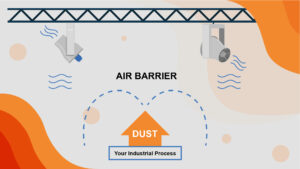Why is Paper Dust Such a Hazard?
Packaging material. Printing paper. Personal care products. The paper industry produces a vast range of items in facilities across the country. What else does the industry produce every day? Combustible dust.
As manufacturers create various paper products, facilities generate combustible dust in the forms of pulp, wood, coal, ashes, resins, and starch. When this combustible dust collects on surfaces and remains confined in a plant, it takes just one ignition source to initiate a potential disaster. Open flames, hot surfaces, and electrostatic discharges are a few potential ignition sources in paper manufacturing and conversion facilities.
When these conditions are right, combustible dust can create an explosion and/or fire, injuring employees and crippling the business. Prolonged exposure to paper dust can also cause additional health risks for employees, such as respiratory illness.

To mitigate these risks, paper industry professionals must properly manage the combustible dust in their facilities. Solutions have improved over the years, but not all are effective. The Combustible Dust Incident Report from 2023 shows 7 combustible dust incidents in the North American pulp and paper industry. Manual housekeeping isn’t getting the job done for paper manufacturers, and dust collection systems alone cannot capture all the dust created. The industry needs a proactive solution that effectively protects paper manufacturers and paper converters from combustible dust events.
What Does Hands-Free Clean Up Look Like? One Paper Facility Takes on Combustible Dust
Texas Tissue knew they needed to update their dust mitigation practices. They were spending too much, working too hard, and still falling short. They were constantly working to maintain an environment safe from combustible dust for their employees.
They needed a hands-free solution that guaranteed compliance, and SonicAire gave it to them. Watch the video to learn how drastically their facility has improved after installing SonicAire dust management fans.
Here’s How Easy We’ll Make Fugitive Dust Management in Your Facility
What Does Hands-Free Clean Up Look Like? One Paper Facility Takes on Combustible Dust
Texas Tissue knew they needed to update their dust mitigation practices. They were spending too much, working too hard, and still falling short. They were constantly working to maintain an environment safe from combustible dust for their employees.
They needed a hands-free solution that guaranteed compliance, and SonicAire gave it to them. Watch the video to learn how drastically their facility has improved after installing SonicAire dust management fans.
Paper Dust Regulations
NFPA (National Fire Protection Association) has consolidated several of its combustible dust standards to encompass all those concerns in one location, saving us from inconsistencies. This standard, NFPA 660, was published in 2024, but to read more on it, check out our blog on NFPA Standard 660.
With this standard in effect, we must hold to the NFPA 660 Standard for Combustible Dusts and Particulate Solids to maintain clean, safe environments for employees.
OHSA (Occupational Health and Safety Administration) has also established the National Emphasis Program (NEP) on combustible dust, focusing on several industries, including paper products. The organization estimates that 30,000 U.S. facilities across all industries are at risk for explosions caused by combustible dust. Additionally, prolonged exposure to paper dust can create health risks for employees, such as respiratory illness, leading to chronic cough, wheezing, or chest tightness.
The standards established by NFPA and enforced by OSHA further encourage plant operators to take steps to reduce the risk in their facilities. Not only are these efforts intended to improve conditions, but they also help ensure owners aren’t subject to the steep fines that OSHA can impose.
Paper Dust Solutions
Recognizing the risk posed by combustible dust, paper product manufacturers are seeking solutions to keep their facilities safe. They are discovering that industrial dust fans are a proactive solution to reduce the risk of dust explosions and fires and create a cleaner, healthier work environment.
The fans generate these improved conditions due to three key features:
- Dust control: Fans for continuous dust control create an air barrier that forces dust particles to the ground. They effectively prevent upward thermal currents from holding dust in the air. This managed airflow prevents the generation of dust clouds and the accumulation of dust on structural components and equipment.
- Fire prevention: A lack of combustible dust accumulation effectively reduces the risk of fires and explosions. Each industrial dust fan system is engineered to provide the optimal prevention for the paper facility in which it is installed. Dust fan manufacturers recommend the ideal location and fan system application for each setting. Facility operators can then use this system to eliminate their risk of overhead combustible dust and help prevent dangerous incidents.
- Convenient maintenance: Industrial dust fans direct dust downward, where it can be removed using regular floor-cleaning methods. This eliminates the need for time-consuming and potentially dangerous housekeeping efforts in hard-to-access areas. The fans can be set to run automatically and operated using convenient control panels.
Here’s How Easy We’ll Make Fugitive Dust Management in Your Facility

DISCOVER
We’ll identify your biggest dust control challenges.

DESIGN
We’ll develop an engineered system specifically for your facility.

DELIVER
Your fans can be installed by you or a qualified contractor.

DEFEND
You’ll know you’re protected from future dust accumulation.
SonicAire at Work in the Paper Industry
We installed SonicAire fans throughout our plant because we wanted to find a superior way to deal with the problems of combustible dust. We needed a higher level of continuous clean … the fans have delivered everything we wanted!
We installed SonicAire fans over our paper machines to prevent dust from accumulating in the first place. Not only do they keep our plant continuously compliant with OSHA regulations, they keep our employees safer.
Best investment made for the mill in a long time.
Our board of directors and OSHA consultants were very impressed with how well the fans operate in our facility.
These things are amazing, at first, folks here didn’t like the idea – but now, everyone who sees these things is asking if they can get them too.
What is a Dust Hazard Analysis?
With years of experience in testing and consulting on combustible dust hazards and nearly a century of operations focusing on safety, DEKRA is an excellent all-around resource for your specialized demands.
Click the video below to watch this conversation and discover the best next steps once you’ve completed your DHA.
How Do SonicAire Fans Prevent Dust Buildup?
SonicAire’s proprietary technology combines two methods to control dust flow.
High-Velocity Airflow
SonicAire’s specialized fans use high-velocity airflow to clean overhead areas. This ultra-powerful airflow effectively prevents the accumulation of combustible dust on overhead structures and provides better dust control for your wood production facility. The technology behind these fans will automate your dust management, operating in the background without any extra thought from you or your employees.


Thermal-Current Control
Typical airflow involves warm air currents naturally rising and lifting dust to overhead structures, where it accumulates quickly. SonicAire’s industrial dust control fans prevent these naturally occurring upward thermal currents from holding dust in the air in the first place. Our fans create an air barrier below the overhead structures so the dust doesn’t rise above them and settle on top. When dust isn’t given free-reign in a facility the air quality will also inevitably improve.
With these unique and efficient approaches, our specialists design a customized plan, especially for your facility, to ensure that the dust accumulation in your facility is kept at a safe, minimal level.
SonicAire can mitigate the danger of combustible dust in your facility; reach out to speak to one of our specialists to get started. We’ll guide you through exactly how to make your workspace as safe as possible from dangerous buildup, while also saving you time and money from manual cleaning, insurance costs, and OSHA fines.
What You Need to do to Avoid a Combustible Event
If you know you have a combustible dust problem but don’t know how to operate with it as an added priority, it’s worth considering the worst-case scenario. How can you avoid a combustion event in your facility?
In this webinar, the COO of SonicAire, Jordan Newton, sits down with Chris Cloney, the Founder of Dust Safety Science, to discuss the dangers of a combustible dust event and how to avoid it.
Additional Resources
Learn more about how we helped companies like yours find solutions to their dust problems.
Complimentary Dust Management Plan with ROI Analysis

Our analysis will also show you the expected Return on Investment, including equipment investment, estimated annual savings and cumulative cashflow benefit.
Get started by contacting us today for your custom facility review, ROI analysis and fan technology proposal.
Paper Industry Overview
In a world of digital solutions, the paper industry continues to grow. Successfully adapting to demands, the industry has scaled back in graphic paper production while ramping up supplies for packaging, hygiene product, and tissue paper manufacturing.
In the U.S. alone, paper mills are expected to reach a value of roughly 373 billion U.S. dollars by 2029. Much of this was in response to high domestic demand: each American uses 700 pounds of paper per year in various product consumption. The country remains second only to China in the production and consumption of paper.
Major manufacturing categories for the paper industry include:
- Pulp
- Coated Groundwood
- Coated and Uncoated Freesheet
- Paperboard
- Personal Care Products
- Transport and Industrial Packaging
- Consumer Packaging and Tissue
- Graphic Papers
- Fiber
Get Your Complimentary Dust Management Plan with ROI Analysis

Our analysis will also show you the expected Return on Investment, including equipment investment, estimated annual savings and cumulative cashflow benefit.
Get started by contacting us today for your custom facility review, ROI analysis and fan technology proposal.




